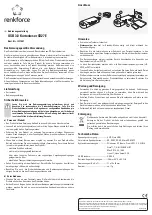
KPCI-3110 and KPCI-3116 User’s Manual
Systematic Problem Isolation
C-21
NOTE
If the analog outputs appear to work satisfactorily, but some measured
analog output voltages are outside the accuracy limits specified in
Appendix A, consider calibrating your board after concluding the sys-
tematic problem isolation procedure. For calibration procedures, refer
to
Section 5
, “
Calibration
.”
General-purpose digital I/O hardware test
This test checks whether the general-purpose digital input and output circuits of the board are
operating properly.
All I/O is set and read using the DriverLINX Digital Input/Output test panel, and no instruments
are required. However, you must wire an STP-3110 screw terminal accessory in the loop-back
configuration
.
If possible, use a screw terminal accessory that is reserved for I/O tests. Avoid
using a screw terminal accessory that is normally connected to your external circuits. You
thereby avoid the extra labor and potential wiring errors involved in disconnecting and later
reconnecting your external circuits.
The following summarizes the test procedure:
•
Wire an STP-3110 screw terminal accessory in a loop-back configuration. Connect the chan-
nel 0 digital I/O terminals, bit-for-bit, to the channel 3 digital I/O terminals. Connect the
channel 1 terminals, bit-for-bit, to the channel 2 terminals.
•
Using a DriverLINX graphical interface, configure the channel 0 and 1 bits as outputs and
the channel 2 and 3 bits as inputs.
•
Using the same DriverLINX graphical interface, set the channel 0 and 1 outputs in a
particular bit pattern and check channels 2 and 3 inputs for the same bit pattern. Repeat,
using a second bit pattern.
The digital I/O of the board is performing satisfactorily if all bits respond appropriately. Choose
bit patterns that check both for direct ON/OFF response and for shorts between bits.
Specified software I/O tests
The tests in this section check whether your application software correctly performs analog and
digital I/O tasks. The I/O are tested using a KPCI-3110 or KPCI-3116 board known to work
properly, thereby bypassing potential board problems. These tests are intended to be used when
specified in the preceding
systematic problem isolation procedure.
NOTE
During these tests, disconnect all user circuits from the board, except for
connections specified in individual test procedures.
Summary of Contents for KPCI-3110
Page 3: ......
Page 4: ......
Page 7: ......
Page 8: ......
Page 16: ...Preface...
Page 20: ...1 Overview...
Page 25: ...2 Functional Description...
Page 54: ......
Page 55: ......
Page 57: ......
Page 58: ......
Page 59: ......
Page 61: ...3 Installation and Configuration...
Page 66: ......
Page 68: ......
Page 80: ......
Page 81: ......
Page 82: ......
Page 83: ......
Page 84: ......
Page 85: ......
Page 86: ...4 Testing the Board...
Page 89: ...5 Calibration...
Page 92: ...6 Troubleshooting...
Page 99: ...A Specifications...
Page 111: ...B Connector Pin Assignments...
Page 116: ...C Systematic Problem Isolation...
Page 143: ...D Using Your Own Screw Terminal Panel...
Page 156: ......
















































